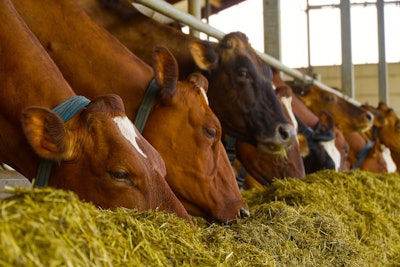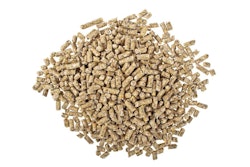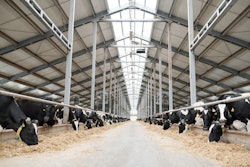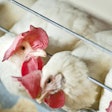
Ongoing research, models reveal added productivity
Models, such as the National Research Council (NRC) and the Cornell Net Carbohydrate and Protein System (CNCPS), have been instrumental in streamlining and improving the formulation of diets for dairy cows. Inroads have been particularly outstanding with respect to protein and amino acid nutrition of dairy cows. Granted we are still discovering more each day about the nutritional needs of dairy cows, but models and feed formulation platforms are allowing us to achieve greater levels of productivity and to make better use of the resources available.
Amino acids
With respect to protein and amino acid requirements, the objective is to match the supply of amino acids with target requirements without major excess. Factorial estimation of protein and amino acid requirements have been developed by NRC and CNCPS in North America, as well as other models worldwide. The requirements determined in these systems are based on the composition of meat and milk, and have been shown similar across all platforms varying only somewhat by the efficiency factors that are applied.
The supply side, however, imposes a few more challenges. Amino acids are delivered to the intestine for absorption by feed and by microbial protein. Believe it or not, estimations of microbial protein potential are reasonably accurate, and there are likewise reliable results for the amino acid composition of rumen microbial protein. Estimations of rumen microbial protein as determined by marker systems and gas production systems have been beneficial in establishing the appropriate independent variable within model platforms. The amino acid composition of rumen bacteria and protozoa has been accurately described.
Protein utilization
The major stumbling block remains the determination of portion of the protein provided from feed ingredients that is used in the rumen, i.e. rumen degraded protein (RDP) to support the rumen microbes, and the portion that will escape the rumen, i.e. rumen undegraded protein (RUP). Errors in estimating how feed proteins are partitioned consequence the ability to support optimum rumen microbial growth, as well as the calculation of the amounts of amino acids entering the intestine from microbial and feed ingredient sources. These values must match amino acid requirements in order to optimally support lactational needs and sustainability.
One major fault in determining the site and extent of amino acid digestion is the continued heavy reliance on in situ analyses as the standard for determining RUP and RDP. With the in situ method, samples of feed are placed in porous bags and are incubated in the rumen of cannulated animals for varying lengths of time. The amounts of protein and amino acids that disappear from the bags are then assumed to be available for microbial production, and the portion that does not disappear is assumed to enter the intestine for additional digestion by the host animal.
This method produces incorrect results and results that are often misinterpreted.
Soluble protein
Researchers have known that soluble protein is not equivalent to degraded protein for more than 40 years. Well-referenced articles do not support the concept that all or even most soluble protein is available in the rumen. Soluble protein is simply protein that can go into solution. The actual structure of the proteins in solution determines its actual resistance to degradation.
RDP is often considered to be the sum of the soluble protein fraction of feed plus the component of the insoluble fraction of feed that is rendered soluble. The fate of soluble protein cannot be predicted from in situ rumen incubation studies. Insoluble protein becomes soluble at the rate determined by the in situ test to be the “degradation rate.” However, this protein can become soluble when surrounding structures, such as cell wall, becomes broken, or when microbial proteases result in the formation of soluble — but not necessarily degradable — peptides.
Vegetable protein |
Soluble protein, % of total crude protein |
Rate of digestion, % degraded/hour |
| Canola meal (rapeseed meal) | 20.4 | 19 |
| Flax (linseed meal) | 58.6 | 18 |
| Lupins | 80.2 | 34 |
| Peas | 77.8 | 39 |
| Soybean meal | 16.9 | 46 |
| Wheat distillers’ grains | 24.3 | 62 |
True degradation rates for the soluble fraction of proteins. (Hedqvist and Udén, 2008)
Canola meal and flax meal degrade much more slowly than soybean meal or wheat distillers’ grains. This means there is considerable opportunity for the soluble fraction to reach the intestine. Add to that the fact that soluble protein will exit the rumen with the liquid outflow, which is at least twice as fast as the solid turnover rate. This would likewise apply to the protein that becomes solubilized while suspended in the rumen during the in situ analyses.
The net result is that assumptions that occur when soluble protein and solubilized protein is assumed to be degraded means the amino acids available to the animal can be quite different than predicted. The microbial component can well be underestimated if degraded protein is overestimated. Additionally, ingredient amino acid contributions can be underestimated, resulting in an amino acid profile that reflects the diet more and the rumen microbes less than assumed.
Modeling essential
Models were initially developed to assist in ensuring animals meet their potential to produce milk and meat. Refinements have resulted in ongoing incremental improvements and providing insight as to future research needs. By better establishing and then providing nutrients closer to reality, it is possible to maintain or improve productivity and production efficiency.
Ruminants are key elements of a sustainable agricultural system, with their ability to convert inedible materials such as grasses and food waste byproducts into valuable foods. While tremendous improvements have been made, improvements are still needed. Models must accurately reflect the dynamics of feed going through the rumen as accurately as possible.
Models will never be completely correct, but the failure to accept the need for change slows progress.
References available upon request.















